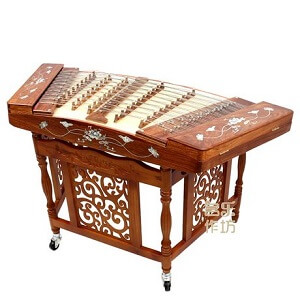Yangqin
 The yangqin is believed to have originated in Central Asia, but was in fact first brought to China by sea-faring European traders at the end of the Ming Dynasty (around AD 1600) - this is evident from how popular the yangqin is in the coastal trading regions around Guangdong. It was consequently popularized throughout the whole of China, even through areas as far as Tibet and Xinjiang.
The yangqin is believed to have originated in Central Asia, but was in fact first brought to China by sea-faring European traders at the end of the Ming Dynasty (around AD 1600) - this is evident from how popular the yangqin is in the coastal trading regions around Guangdong. It was consequently popularized throughout the whole of China, even through areas as far as Tibet and Xinjiang.
The Chinese yangqin is sounded by using bamboo sticks with hammer tips to strike its strings. The bridge peak that supports each group of strings help create tension, so that striking the strings produce a note. This sounding methodology is what gives the yangqin its characteristic reverberating quality.
Today, the yangqin and its foreign “counterparts” are called by different names in various countries, but it is generally known by its English name hammered dulcimer. Xu adds, “The yangqin is the only musical instrument that has similar versions of it being played in more than 60 countries.”